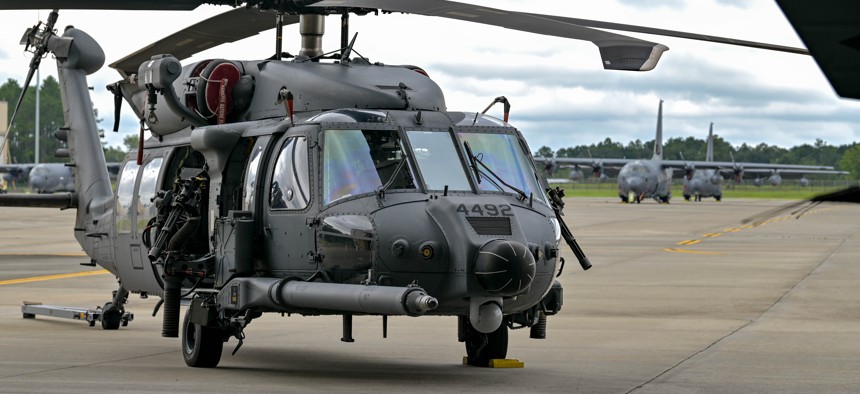
A Lockheed Martin HH-60W Jolly Green II helicopter sits on the flight line on Sept. 9, 2022, at Moody Air Force Base, Georgia. U.S. Air Force Senior Airman Rebeckah Medeiros
Air Force deal sets a precedent others should follow
By obtaining the data rights for two helicopters, the service sets itself up to save money and improve readiness.
Taxpayers and troops alike should celebrate the Air Force’s new deal with Lockheed Martin and Boeing. By acquiring the technical data rights for two new helicopter programs, the service will be able to better maintain equipment at a much more reasonable cost. Its sister services should follow the Air Force’s lead.
Access to the technical data packages for the Lockheed HH-60W combat rescue helicopter and the Boeing MH-139A utility helicopter will supply the information the Air Force needs to modify and maintain the helicopter systems, whether in-house or by negotiating sustainment contracts with a variety of contractors.
It’s a sea change for the Pentagon, which has long ceded too much control over weapons development to defense contractors, giving them a monopoly on contracts to maintain the weapons they develop at a high cost. No program has suffered from this more than the F-35. The government failed to acquire the data rights as part of the original contract awarded to Lockheed in 2001. This has led to several fights between the Pentagon’s program office and the company, as well as problems that remain unresolved to this day.
The Air Force is currently in a fight with Lockheed over the data rights related to software for an F-22 and F-35 training simulator at California’s Edwards Air Force Base. The facility will be used to train pilots when it opens next year if the company and the government can come to terms over software licensing.
This is a familiar problem for that program. The F-35 has yet to reach full-rate production, in part because of delays with another simulator to be used as part of the operational testing process. The development of that simulator was delayed several years ago, in part because Lockheed Martin failed to deliver in timely fashion the necessary technical data in the form of software needed to digitally replicate the F-35 and its aerial performance in the simulated environment. If the Pentagon had that data in the first place, it would not have been beholden to Lockheed’s timeline for developing the simulator.
In the case of the F-35, Pentagon contracting officials made a conscious decision at the beginning of the program not to include the transfer of data rights. An acquisition fad known as Total System Performance Responsibility saw the government effectively surrendering to the contractors its responsibility to maintain the equipment purchased with taxpayer dollars. The thinking behind the strategy was that private industry could more efficiently perform basic maintenance functions of the weapons it produced. But the scheme provided contractors with little incentive to design simple and easy-to-maintain weapons, because the real money to be made with a program like the F-35 was made through sustainment contracts.
Indeed, Pentagon officials inked a deal with Lockheed Martin for a contract worth up to $6.6 billion in 2021 to support the F-35 fleet through 2023. Such contracts will grow even larger as more aircraft are delivered. And because Lockheed controls the technical data for the F-35, the company enjoys an absolute monopoly on all future contracts.
While this business model has helped pad bottom lines for the defense industry, it hasn’t produced the kind of results the services need. F-35 readiness rates have been poor compared to programs controlled by the government. The Congressional Budget Office released data in early 2023 showing that overall readiness rates for the program declined in the previous two years. The availability rate of the Air Force’s F-35A fleet fell by 11 points during that time.
It is satisfying to see Pentagon leaders finally heeding the warnings that have been available for all to see for years. Data rights for weapon acquisition programs are fundamental for military effectiveness. The government should maintain full control of the items it purchases. This will be particularly important as the Pentagon embarks on a new round of major acquisitions like the Next Generation Air Dominance program.
Getting this issue right now will help reduce instances of underperforming weapons and keep costs down. To be sure, a great deal of reform work remains to be done, but the transfer of technical data packages for two relatively small helicopter programs is an important step forward.
Dan Grazier is the Senior Defense Policy Fellow at the Center for Defense Information at the Project On Government Oversight.



